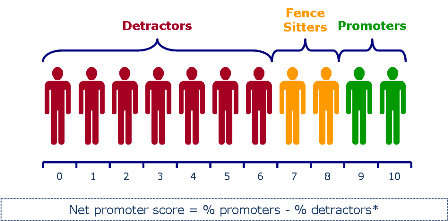Use NPS follow-up insight to convert Detractors and Passives

The ability to quickly gauge your enterprise’s overall health with a single NPS score is useful to let you know whether you need to make any changes. However, a lone NPS score is not enough to tell you what changes you need to make.
The Net Promoter Score has become a popular customer loyalty metric, but you need more than a simple measure of the likelihood of receiving customer recommendations to help you identify organizational problems in enough detail to chart a course for corporate success.
That’s why the metric’s proponents are now recommending you ‘close the loop’ with follow-up questions that get to the root of your customers’ neutrality or lack of satisfaction.
‘Close the loop’ with a NPS-integrated solution
Enterprises looking to transform their Net Promoter Scores into actionable insight should be considering a NPS-integrated solution.
Companies like Kampyle provide such services to help clients:
- Ask the right questions in the right way
- Dig more deeply into data
- Take immediate action based on their new found knowledge
Dig deep for actionable insight to improve brand performance
Following up the standard NPS question, “How likely are you to recommend our service/product to a friend or colleague?”, is critical in order to discover what is driving customers to be Promoters, Detractors or Passive.
Follow-up answers often provide the key to understanding what changes the brand needs to make to increase growth.
To maximize feedback rates, customers must be able to address the “Why?” question(s) intuitively and quickly. Actionable information might include, for example:
- Demographic groups or geographic regions experiencing an issue
- The scores typically given by high value or frequent customers
- Topics or keywords frequently appearing in customer feedback
In today’s complex business environment you need a feedback solution that gives you a Net Promoter Score simultaneously accompanied by a comprehensive analysis of all the underlying data.
Access Quick Win – Run an effective CSAT survey
Learn tips, tools and questions for Customer Satisfaction and Net Promoter Score surveys.
Access the Run an effective CSAT survey
Convert Detractors and Passives into Promoters
In the world of actionable NPS, your goal is gaining insight on what needs fixing so you can chart an informed course for increased customer satisfaction and out-sized corporate growth. On a practical level, converting Detractors and Passives into Promoters is a key part of this process.
Detractor follow-up is usually more straightforward than the follow-up on Passives. Detractors frequently provide detailed actionable feedback that allows you to address problems directly and, invariably, leads to a delighted customer or Promoter.
Passives, on the other hand, are much more difficult to deal with than Detractors as a result of their very neutrality. Generally speaking, Passives are reasonably satisfied with your product or service, don’t have any burning issues and yet they are still unlikely to enthusiastically recommend your company.
A lack of a concrete problem to target and fix makes converting Passives into Promoters a challenge.
A follow-up strategy to convert 'Passives'
Customers who give you a NPS score of 7 or 8 are Passives.
While not as negative as Detractors, this group brings little in the way of positive energy to your business. They are not very likely to recommend your product or service and are vulnerable to switching to your competitors.
The question is “What exactly can you do about it?”
Despite the difficulty involved in converting Passives, they are an important customer segment you should try to win over.
Here are three possible approaches to help you establish why Passives feel the way they do about your brand that should give you an actionable result:
- Craft a customized follow-up question specifically for Passives in your industry/space. Imagine you are the Passive and are being asked the follow-up question. What would catch your attention and get you to respond in detail about your experience?
- Communicate to the Passives that you take their feedback seriously. You can highlight this on your website, company newsletter and social media outlets. (Case studies showing how Detractors were converted to Promoters when their feedback led to improvement and change are ideal for this.) This approach offers dual benefits. It shows Passives that your company truly has the customer in mind – something most people would consider worth recommending. Additionally, it encourages Passives to respond with detailed feedback as they can see it really can make a difference.
- In the online environment, use page-level, feedback forms that make it easy for everyone, even the most dispassionate Passives, to leave categorized and detailed feedback. The shorter and easier it is to share feedback, the higher the chance that customers will actually do so.
And finally, disseminate insight to in-house teams
After collecting and analyzing your NPS score and all related information, you need a feedback solution to easily and automatically share the custom reports with relevant in-house teams.
In this way your sales, support and operation staff are alert to situations where they can convert potentially lost sales, provide loyalty-building assistance and continuously improve on every aspect of the user experience.
Information sharing is the vital final part of the feedback process, allowing the teams to implement any changes necessary to improve overall corporate performance.

Thanks to
Ariel Finkelstein for sharing his advice in this post. Ariel is co-founder of
Kampyle, a leading feedback solutions supplier. connect on
LinkedIn.





 Thanks to
Thanks to 



